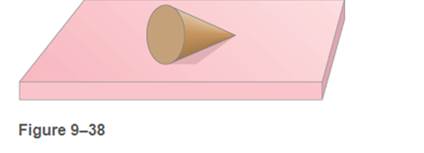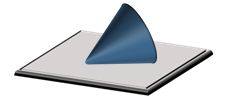
Concept explainers
Figure 9-38 shows a cone. Explain how to lay it on a flat table so that it is in (a) stable equilibrium, (b) unstable equilibrium, (c) neutral equilibrium.

(a) To Determine:
Explain how to lay it on a flat table so that it is in: stable equilibrium
Answer to Problem 10Q
Solution:
Place the base of the cone on the surface of the table and it will remain in stable equilibrium.
Explanation of Solution
An object that is in stable equilibrium returns to its initial position. In our case place the base of the cone on the surface of the table as shown in figure 1, then apply a force pushing on the top of the cone, then stop pushing and observe that the cone returns to its initial state of equilibrium.

Figure 1
(b) To Determine:
Explain how to lay it on a flat table so that it is in: unstable equilibrium
Answer to Problem 10Q
Solution:
Place the tip of the cone on the surface of the table and will be in unstable equilibrium.
Explanation of Solution
An object that is in unstable equilibrium does not return to its initial position. In this part place the tip of the cone on the surface of the table as shown in figure 2, then release the cone and observe that it does not return to its initial state.

Figure 2
(c) To Determine:
Explain how to lay it on a flat table so that it is in: neutral equilibrium
Answer to Problem 10Q
Solution:
Place the lateral part of the cone on the surface of the table and this will remain in neutral equilibrium
Explanation of Solution
An object that is in neutral equilibrium reaches another position different from the one it had at the beginning and remains there. In this part, place the side of the cone on the surface of the table as shown in figure 3, then push the cone with your finger and you will notice that it immediately changes position and remains at that new point.
 Figure 3
Figure 3
Chapter 9 Solutions
Physics: Principles with Applications
Additional Science Textbook Solutions
Microbiology with Diseases by Body System (5th Edition)
College Physics: A Strategic Approach (3rd Edition)
Anatomy & Physiology (6th Edition)
Cosmic Perspective Fundamentals
Human Anatomy & Physiology (2nd Edition)
Chemistry: The Central Science (14th Edition)
- 2arrow_forward3arrow_forwardImagine you are out for a stroll on a sunny day when you encounter a lake. Unpolarized light from the sun is reflected off the lake into your eyes. However, you notice when you put on your vertically polarized sunglasses, the light reflected off the lake no longer reaches your eyes. What is the angle between the unpolarized light and the surface of the water, in degrees, measured from the horizontal? You may assume the index of refraction of air is nair=1 and the index of refraction of water is nwater=1.33 . Round your answer to three significant figures. Just enter the number, nothing else.arrow_forward
- 20. Two small conducting spheres are placed on top of insulating pads. The 3.7 × 10-10 C sphere is fixed whie the 3.0 × 107 C sphere, initially at rest, is free to move. The mass of each sphere is 0.09 kg. If the spheres are initially 0.10 m apart, how fast will the sphere be moving when they are 1.5 m apart?arrow_forwardpls help on allarrow_forwardpls help on thesearrow_forward
- pls help on all asked questions kindlyarrow_forwardpls help on all asked questions kindlyarrow_forward19. Mount Everest, Earth's highest mountain above sea level, has a peak of 8849 m above sea level. Assume that sea level defines the height of Earth's surface. (re = 6.38 × 106 m, ME = 5.98 × 1024 kg, G = 6.67 × 10 -11 Nm²/kg²) a. Calculate the strength of Earth's gravitational field at a point at the peak of Mount Everest. b. What is the ratio of the strength of Earth's gravitational field at a point 644416m below the surface of the Earth to a point at the top of Mount Everest? C. A tourist watching the sunrise on top of Mount Everest observes a satellite orbiting Earth at an altitude 3580 km above his position. Determine the speed of the satellite.arrow_forward
 College PhysicsPhysicsISBN:9781305952300Author:Raymond A. Serway, Chris VuillePublisher:Cengage Learning
College PhysicsPhysicsISBN:9781305952300Author:Raymond A. Serway, Chris VuillePublisher:Cengage Learning University Physics (14th Edition)PhysicsISBN:9780133969290Author:Hugh D. Young, Roger A. FreedmanPublisher:PEARSON
University Physics (14th Edition)PhysicsISBN:9780133969290Author:Hugh D. Young, Roger A. FreedmanPublisher:PEARSON Introduction To Quantum MechanicsPhysicsISBN:9781107189638Author:Griffiths, David J., Schroeter, Darrell F.Publisher:Cambridge University Press
Introduction To Quantum MechanicsPhysicsISBN:9781107189638Author:Griffiths, David J., Schroeter, Darrell F.Publisher:Cambridge University Press Physics for Scientists and EngineersPhysicsISBN:9781337553278Author:Raymond A. Serway, John W. JewettPublisher:Cengage Learning
Physics for Scientists and EngineersPhysicsISBN:9781337553278Author:Raymond A. Serway, John W. JewettPublisher:Cengage Learning Lecture- Tutorials for Introductory AstronomyPhysicsISBN:9780321820464Author:Edward E. Prather, Tim P. Slater, Jeff P. Adams, Gina BrissendenPublisher:Addison-Wesley
Lecture- Tutorials for Introductory AstronomyPhysicsISBN:9780321820464Author:Edward E. Prather, Tim P. Slater, Jeff P. Adams, Gina BrissendenPublisher:Addison-Wesley College Physics: A Strategic Approach (4th Editio...PhysicsISBN:9780134609034Author:Randall D. Knight (Professor Emeritus), Brian Jones, Stuart FieldPublisher:PEARSON
College Physics: A Strategic Approach (4th Editio...PhysicsISBN:9780134609034Author:Randall D. Knight (Professor Emeritus), Brian Jones, Stuart FieldPublisher:PEARSON





